Chapter Two
Part Four
| Having considered the newcomers to
the industry we will now look at the old established firms,
and first Wearwell. Their machines were now known as Wolfs
and as far as motorcycles are concerned the firm was known
as Wolf Engineering. |
 |
Wolf exhibited a machine at the 1908
Stanley Show which they claimed to be the lightest and
cheapest on the market. It weighed 60lbs and cost 19guineas
(£19.95) so the claim could well be justified. This
lightweight had its 1.25h.p. air-cooled engine mounted high
in the frame just behind the steering head. This could be
seen as a backward step in motorcycle design as most
machines now had the engine mounted down near the bottom
bracket. |
| A twisted leather belt took the
drive to the rear wheel and there was neither a clutch
or gears.
The following year the engine had been increased to
2h.p. and a 'V' belt substituted for the round one. This
model was listed as the 'Royal'. The 'Super' used the
same engine but mounted low in the frame. Though this
could be seen as an improvement the critics did not like
it, being of the opinion that the top tube, which curved
sharply up to the steering head was a very weak point.
However a 3.5h.p. 'V' twin came in for much praise from
show visitors and the press.
Engines used in
Wolf machines were designed by Harry Stevens, whose
company J. Stevens and Sons supplied engines to numerous
manufacturers. One such customer being Clyno who had
works in the Northamptonshire village of Thrapston. |
| Founded by two cousins Frank
and Ailwyn Smith to produce pulleys for belt drive
motorcycles, it is said that the inclined faces of
these gave the name Clyno.
When they decided to build complete machines they
chose Stevens engines and soon felt that it would be
better to be nearer the engine supplier, also no
doubt appreciating the better supply of skilled
engineers in the midlands. |
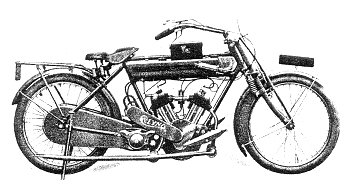
A Clyno "Continental" from
1912. |
| In any event they decided to move to
Wolverhampton and took over the Pelham Street premises
vacated by Stevens when they moved to Retreat Street. Clyno
would grow to be very important in the motorcycle and later
motor car industry. But now to
the birth of a very famous motorcycle. Sometime around 1908
the Stevens brothers decided to build complete machines and
towards the end of the following year were able to place two
models before the public, after extensive testing of
prototypes.
Though engines would continue to be
supplied to the trade under the Stevens name they wished to
have something different on the tanks of their machines.
Albert Jack was the only brother with a middle name, so it
was his initials that were chosen for the famous A.J.S.
trademark. |
|
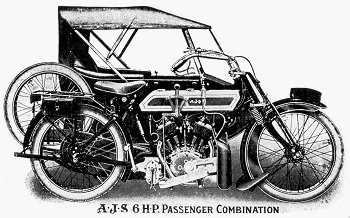
From a 1914 advert. |
The first A.J.S. or
AJs as they would become known was the model 'A' which had a
2.5h.p. single cylinder air cooled engine with side valves,
cylinder dimensions of 70 x 77.5mm and a capacity of 298c.c.
Druid forks were
fitted but there were neither clutch or gears and a
belt drive was used. It sold for 37guineas (£38.85). |
|
The model 'B' had the
same engine, frame and forks, but a two speed countershaft gear,
clutch and all chain drive, selling for 44guineas (£46.20). Both
models were of first class quality in materials and workmanship
and finished in best black enamel. Bright parts were nickel
plated and the tank was silver with black panels lined with
green. Good numbers of orders were soon coming in for the
attractive machine and the factory kept very busy indeed.
We will stay with
A.J.S. for a while longer, though it will take us well ahead
of our story. It will be remembered that the Stevens
brothers were all keen on competition events and when the
Auto Cycle Union moved the Isle of Man Tourist Trophy races
to the famous 37 mile circuit that took in the mountain,
which is much the same as used to this day, A.J.S. decided
to have a go. |
|
This first T.T. over the
long circuit took place in 1911. By now the Stevens had a good
business manufacturing motorcycles and entered two machines for
the Junior race, which was restricted to machines of up to
300c.c. in the case of single cylinder engines and 340c.c. for
twins. This much favoured the multi cylinder machines and indeed
it would be 1914 before a single won a T.T. race. The two A.J.S.
machines to be ridden "by Jack Stevens himself and private owner
J.D. Corke were very similar to the catalogued models, though
tuned up somewhat with the stroke lengthened to 77.5mm, giving a
capacity of 298c.c.
As far as the Wolverhampton machines
are concerned the story of the 1911 Junior T.T. is soon
told. Race winner P.J. Evans, later to found the famous
Birmingham car distributors that still bear his name, won on
a Humber at an average speed for the 150 miles of
41.45m.p.h. He also set the fastest lap with a time of
53minutes 24 seconds at an average speed of 42m.p.h. |
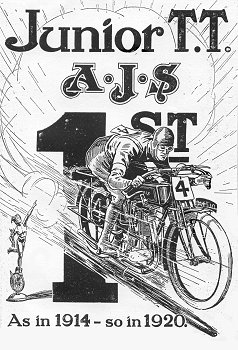 |
|
During the race Jack
Stevens had been going very well in 6th position, but took a
nasty tumble which twisted the forks. He carried on to finish 16th,
one place behind Corke. Jack Stevens had done what he had set
out to do, competed in the world's greatest road race and
finished proving the reliability of the A.J.S. The marque would
of course go on to great things in the motorcycling world.
The A.J.S. showing
in the T.T. brought forth increased orders and the works
were kept so busy meeting this demand that no thought could
be given to preparing machines for the following years T.T.
so this would be a convenient point to go back a few years.
First we will note a little known commercial vehicle made in
Wolverhampton.
The Sedan lorries were
of French origin but the Sedan Auto Car Syndicate was formed
with offices in London to manufacture vehicles in England. The
address given in advertisements for the factory seems rather
unlikely, being Lichfield Street, Wolverhampton. The connection
with the town is proved by the index number of the vehicle that
appeared on the company's illustrations, DA 286.
The Sedan was an
unorthodox vehicle with a front wheel drive. It had a 22h.p.
horizontally opposed twin cylinder engine under a coal scuttle
shaped bonnet with a radiator mounted behind the driver. It was
a very early example of an articulated lorry and had a very
small turning circle. Very few Sedan's can have been made though
it is known that Coalite used at least one two tonner for coal
deliveries during 1910.
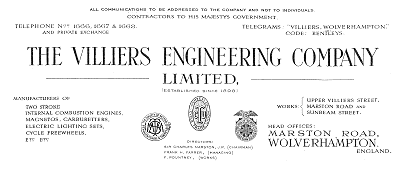
|
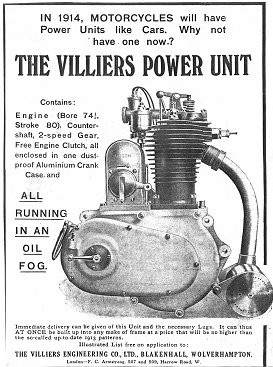 |
Though they would not manufacture
complete motor vehicles, Villiers played such an important
part in the industry that they deserve a mention in this
story. The Villiers Cycle Components Company had been
founded by John Marston in 1898 with his eldest son Charles
in charge. The firm had prospered producing high grade
pedals and other components for Sunbeam cycles and had also
been able to supply many other manufacturers. By 1911 they
were a world renowned and respected firm.
At this time many motor cycles were of the fixed gear
variety, which means they had no variable gear. They had a
direct drive which in most cases was by belt from the engine
to the rear wheel and most were also devoid of a clutch.
Many designs were put on the market to
give variable speeds with a clutch, some of which were by
Villiers. |
| They brought out a free engine hub,
really a clutch within the rear hub of a motorcycle back
wheel, it had a good test when during May 1912 one William
J. Clarke used one to break the six days record in which
time he covered 3,000 miles and found the Villiers free
engine hub very satisfactory.
Now the firm began to think about adding an engine to their
range of products and a four stroke overhead valve engine
with kick start and two speed gear in unit was made and
shown to the trade, however they were not impressed. The
design was so far ahead of the present state of the art. |
|
In view of this
attitude Frank Farrar, who after several years with the
firm, had in 1912 taken a financial interest in the company,
decided to design a two stroke. A bold move for at this time
two strokes, with the odd exception, were not very good
motors and gave plenty of trouble. However despite a certain
amount of opposition at the works a prototype was built. A
frame was constructed for it and Farrar tested it on the
road. The engine came up to all his expectations and he
could see he had a winner. He soon apprised the company of
this, only to be met with a lot of opposition when it was
suggested that the engine should go into production. |
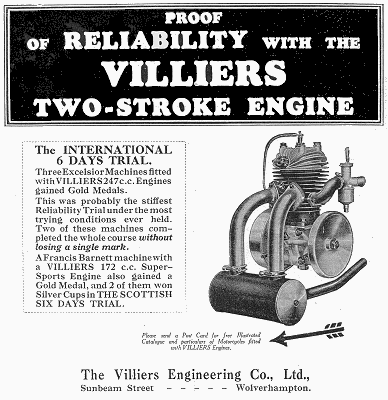 |
| After a great deal of persuasion
Charles Marston agreed to the engine being put into
production, and from 1913 Villiers were able to offer the
269c.c. two stroke to the trade.
It is well known that all this proved to be a great success.
Villiers two strokes would be made by the million and used
in untold applications. Before the engine could really get
going in a big way however, the war came along and Villiers
had to go over to munition production.
We must now come to
another new Wolverhampton motorcycle marque that would attain
fame throughout the world for ordinary use and in every aspect
of motorcycling competition. We refer of course to the Sunbeam.
If John Marston had
taken a lot of persuasion to start making cars he needed
a great deal more to consider motorcycles, for he did not
care for them at all. |
|
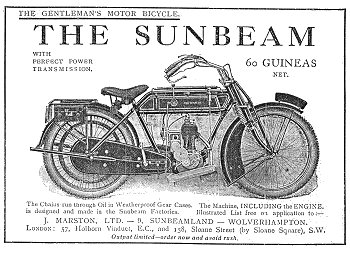
An advert from 1912. |
A number of employees had from the
earliest days tried to get him to change his mind and
produce a powered Sunbeam cycle, but it did not succeed.
None the less there had been some
clandestine experiments by one or two of his workers,
chiefly James Morgan deputy works manager under William
Newill. Morgan had fitted a Swiss made motorcycle engine
into a Sunbeam pedal cycle frame sometime around 1903, and
he rode this machine quite a lot, though perhaps not in John
Marston’s presence. |
|
One Sunday morning while
riding along the Penn Road he had an accident. James Morgan fell
from his machine and died from the injuries received. This of
course put paid to any official Sunbeam involvement in powered
two wheelers and in fact it is said that John Marston forbade
even mention of them in his hearing.
However as the years
passed and motor bicycles became more practical and much more in
demand John Marston at last agreed that they should be produced
in his factory, laying down of course that they should be of the
best possible quality and design. |
| John W. Greenwood who had been with
both the famous Tottenham engine company J.A. Prestwich and
Rover was engaged during 1911 to develop a first class
motorcycle. John Greenwood
remained at Sunbeamland for the rest of his career and his
sons Cyril and Charlie also found employment at Sunbeam,
though later Cyril would move over to A.J.S. |
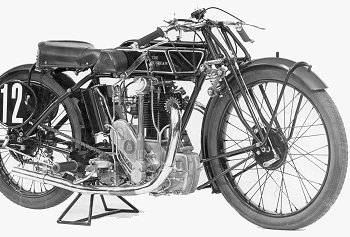 |
|
The first Sunbeam motor
cycle engine and mechanical parts were designed by Harry
Stevens, a brilliant engineer who was responsible for the
Stevens engines that were used in so many applications. His
designs powered Clyno, AJS and the first Sunbeams; three local
marques of great repute.
The first Sunbeam was a
single-cylinder side valve, air cooled machine with cylinders of
75 x 79mm. It was of first class workmanship and materials, and
had as would be expected fully enclosed transmission in oil bath
gear cases. The high quality of the Sunbeam at once earned it
the slogan “The gentleman’s motor bicycle”.
Having taken in the
introduction of a great Wolverhampton motorcycle we return
to Star who for 1910 offered six models and were being kept
busy producing their excellent cars. |
|
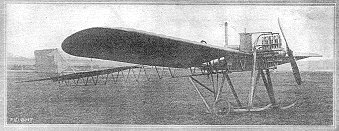
The Star monoplane. |
The young Lisle's were now thinking
of the new flying machines that were coming into the news.
No doubt they had seen some when travelling on the continent
and so it was decided to build aeroplanes at the Frederick
Street works. |
|
A monoplane was designed
by Granville Bradshaw, but the first Star aero engine was
nothing more than a car engine tuned up and lightened a bit. It
turned out to be a complete failure being too low on power and
too high on weight. Two further engines were designed and these
were a much better proposition. The cylinders were each made
from a 4" steel bar, a flange being left at one end for bolting
to the crankcase. The water jackets were copper plated, put in a
plating bath and were 0.125” thick. The process to apply the
plating took three weeks. The complete Star Monoplane, based
rather on the very successful French Antoinette was exhibited at
the 1910 Aero Show, Olympia. When the exhibition finished it
drew many complimentary notices.
After Returning to
Wolverhampton it was entered for the Wolverhampton Flying
Week held during August 1910. Unfortunately it was one of
the wettest summers on record and very little flying was
done. It is not thought that the Star flew at the meeting,
but at sometime Joe Lisle did leave the ground with it in a
brief hop. In no way could it be seen that the design would
prove a success and all thought of building aeroplanes was
sensibly abandoned and the making of fine cars concentrated
upon
Trading profit on motors
was announced as over £20,000, and when Mr. J. Rawlings a
director for over ten years, and one of the largest shareholders
from the beginning of the Star Cycle Co. died, Mr. Edward Lisle
junior was elected to fill the vacant place on the board.
For the 1911 season
Star announced that shaft drive would be used throughout
their range, Rudge Whitworth detachable wheels could be
specified as could direct drive on top. Thee Stars contested
the Standard Car Race at Brooklands and took first three
places only to be disqualified as being non standard. The
prize went to a Singer, however later one of the cars took
the 12 hour record for its class at 67m.p.h.
During 1911 and 1912
the motor trade had its share of ups and downs. In 1911 Star
were very busy turning out about 12 quality cars a week, a
lot of overtime and week end working taking place. The men
got a bit fed up with it all and there was a strike, but
soon settled after one day. By the way the rate for engine
fitters was £1.14s.0d. per week (£l.70.) and with piece work
this could go up to £2.10s.0d.(£2.50.) for a 55 hour week.
During the following year trade went very slack and many
hands were laid off.
The Motor Car Journal
for June3rd, 1911 reported that new extensions were made to the
Star works. The buildings included a new erecting shop, a new
engine test house and across the road extensions to the body
building shops. Wearwell had closed their Pountney Street
factory and Star acquired it, installing plant for castings and
repairs. Later it would be used as the test house.
Towards the end of
1911 all twin cylinder cars were dropped and a new four
cylinder car introduced for 1912. It had a 10h.p. engine
with cylinders of 68 x 120mm looking something like a
miniature Mercedes. It sold for £250, a good motor for the
money. |
| The Star Cycle Company returned to
motorcycle manufacture during 1912. From their Pountney
Street works they offered a single model for the 1913
season. The single cylinder machine, rated at 4.25h.p. had
cylinder dimensions of 89 x l00mm. The 600c.c. motor
developed 5h.p., a rather ingenious carburettor of Star
design was fitted, of the multiple jet type with variable
choke. A collar like device surrounded the top fins of the
cylinder, air being drawn by engine suction through this to
the carburettor. |
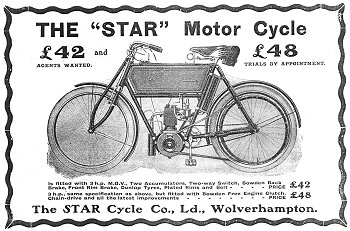 |
| The claim was that the continuous
draft cooled the engine and at the same time heated the air
before it entered the carburettor. The following year this
carburettor was discontinued and a conventional AMAC or
Senspray fitted. No doubt the Star design proved too
expensive to make. Other
features of the 1913 Star motorcycle were free engine clutch
and three speed gearbox. The catalogue was at pains to point
out that these followed car practice. The clutch was of the
leather faced cone variety, mounted on the engine shaft and
operated by a foot pedal, whilst the gearbox was of the
sliding gear type and had direct drive on top. The change
speed lever was mounted on the top tube, a kick starter was
provided and the all chain transmission was fully enclosed.
Forks were of a special design and could be adjusted to suit
the weight of the rider. The machine cost 65 guineas
(£68.25). Star also listed sidecars built under Turner
patents which cost 15 guineas (15.75).
As the life of Star motorcycle
production was so brief we will stay with them to the end.
For 1914 the 4.25h.p. was continued with detail improvements
including an internal expanding rear brake. It was joined by
a big twin machine which had the popular 6h.p. 76 x 85mm JAP
‘V’ twin motor. |
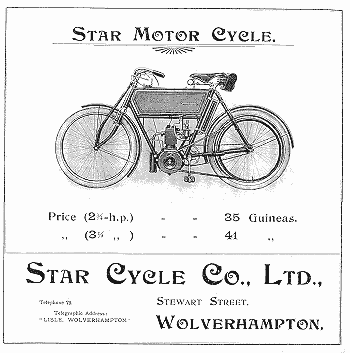 |
The 770c.c. machine cost
75 guineas (£78.75.). A sidecar of Star design was also
introduced and featured plungers in cylinders for springing
rather than the usual laminated ‘C’ springs. It has a good
quality coach built body and cost 16 guineas (£l6.80.).
In their publicity
at this time Star pointed out that oil bath chain cases were
not fitted as too much lubrication interferes with the
clutch on the engine shaft, and the slipping clutch in the
gearbox. An oil bath gear case was however fitted from the
gearbox to the rear wheel. It seems that not all that many
Star motorcycles found customers, production must have been
small. Early in the war production ceased and would not be
started again.
|
|
Much earlier we have
seen how Louis Coatalen, Chief Engineer at Sunbeam was
keen on competition work, and he pursued this interest with
vigour. We now come to a result of this, the first great victory
for a British car in international motor racing.
Sunbeam cars had first
raced abroad during 1911 with a four cylinder car having 80 x
149mm cylinders and a capacity of 2996c.c., giving 58b.h.p. at
2400r.p.m. The specification included a Bosch high tension
magneto, single Claudel carburettor, and a four speed gearbox
with direct drive on third. The race, the Coupe de L’Auto was
over 12 laps of a circuit near Boulogne, a total distance of
387miles. The driver was T. Richards. In the race he was holding
7th place on lap eight when forced out with broken steering.
Coatalen made a much
more determined effort the following year, and his cars had
been tested over the circuit for some months prior to the
1912 race, which would run concurrently with the French
Grand Prix.
|
| Whilst the Coupe cars
were limited to 3 litres there would be no restriction apart
from a maximum width limit for the GP cars so that monsters
of anything up to 15 litres would be taking part.
The race would be tough and held over two
days with drivers required to cover ten 47.5 mile laps on
each day, the total race distance being 956miles, all of
course over ordinary public roads. |
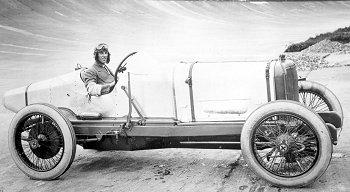
A 150h.p. Sunbeam racer at Brooklands. |
|
For the 1912 Coupe de L
'Auto, Coatalen, who had now been given a seat on the Sunbeam
board, had 4 cars and engaged crack continental drivers for
them: Callois, Dario Resta, Mendinger and Victor Rigal.
All told 31 cars
would contest the Coupe, 14 of them British. 14 would fight
it out for the Grand Prix in which class no British cars
were taking part. On race day first away at 5.30 am was
Rigal on the Sunbeam followed at 30 second intervals by the
remainder. At the end of the first lap Rigal was first
through but when corrected times were posted the lead was
held by Victor Hemery on a Lorraine Deitrich of around 15
litres. He had started 7th, the first of the GP
cars to go. Soon however American Bruce Brown driving a 14
litre Fiat took the lead and he would hold his lead on
subsequent laps. What though of the smaller cars.
|
|
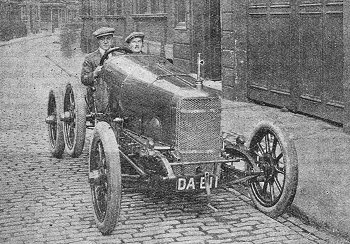
Dario Resta at the wheel of a Sunbeam
Grand Prix racer. |
Well Sunbeam had been dominating the
class and indeed giving many of the GP giant cars something
to think about, so that at the end of the first day’s racing
the overall position was Bruce Brown leading from Georges
Boillot, driving a 7.6 litre Peugeot by a little over two
minutes. Third place was held by Louis Wagner for Fiat, but
fourth overall and leading the Coupe de L'Auto was Dario
Resta about half hour behind. Brown’s team mate Victor Rigal
held 5th place and Medinger 4th. G. Caillois had
retired on lap 8 with engine trouble. |
|
So at the end of the
first day Sunbeam were very well placed in the Grand Prix ahead
of many much more powerful cars, but in their class they
dominated things with 1st, 2nd and 4th places.
Third had gone to Hancock on a Vauxhall.
The second day
proved to be wet and Bruce Brown retained his overnight lead
hotly pursued by Boillot's Peugeot, a battle royal taking
place between these two great drivers. Soon however the Fiat
began to give trouble and Bruce Brown had to retire. This
put Boillot into a very secure position, whilst in the Coupe
Sunbeam held the first three places as Hancock had also been
forced out with mechanical bothers. The little Sunbeams were
also holding 3rd, 4th, and 5th places in the Grand Prix, a
truly magnificent performance, giving quite a few of the big
boys a fright and any designers present something to think
about.
The 1912 French
Grand Prix resulted in a win for Georges Boillot driving a
Peugeot with a time of l3 hours 58 minutes 0.02 seconds for
the two day’s racing at an average speed of 66.45m.p.h.
Second about 12 minutes down was Louis Wagner on the Fiat.
Third came Victor Rigal, something like 40 minutes after the
winner, with team mate Dario Resta next home. Medinger took
5th spot despite trouble in the closing stages. A really
wonderful performance. |
|
Louis Coatalen and
his team of drivers had done a great job for Sunbeam, for
Wolverhampton and indeed for Britain. Their performance
would change the face of motor racing, for these cars were
in no way freaks. The engines being basically standard four
cylinder 80 x 149mm 12/16 motors, but with enlarged valves
and special tuning that produced just over 73b.h.p. at
2600r.p.m. This would mark the end of the giant and often
freak racing cars, some with over five times the engine
capacity of the Wolverhampton cars. The Sunbeam success
caused something of a sensation among the motoring
fraternity. The RAC gave a banquet and special medals were
presented to the drivers and to Louis Coatalen and one to
Mr. W. Ilife for his work as company secretary since its
formation. |
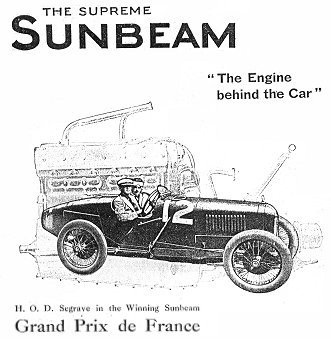 |
|
However some sections of
the press tried to belittle the great victory saying that the
drivers had been French, Coatalen himself was French and so was
the carburettor manufacturer M. Claudel, who had also been
responsible for tuning the cars. All this was so very silly.
Louis Coatalen simply pointed out to the critics that Sunbeam
had taken on the best people available to do a particular job
and had been proved successful. Whatever the press may have said
the success brought increased orders for Sunbeam cars and no
doubt for numerous other British products.
It became necessary to
further enlarge the Sunbeam works. Coatalen demanded and got the
very best machine tools available, many of them from America. At
about this time all the Angus Shaw designed cars were
discontinued and Shaw left to take up a senior position in the
road transport industry. It should perhaps be mentioned here
that Sidney Guy, who had been works manager since 1909 was
running the works. We shall of course be meeting him again later
in the story when he set up on his own account.
In September 1912 the
Coupe de L'Auto cars were taken to Brooklands, now fitted with
single seater bodies to have a crack at some record breaking.
They met with marked success. Drivers were Louis Coatalen, Dario
Resta and R.F. Crossman and the bag of records included 100
miles at 80.34m.p.h., 1,000 miles at 76.1m.p.h., and 391 miles
in five hours. The fastest lap recorded was 86.77m.p.h.
The following year more
records were taken, this time with a six cylinder car driven by
Jean Chassagne, Dario Resta and Kelemn Lee Guiness. As before
many world records fell to the Sunbeam and included 200 miles at
95.92m.p.h. and 1,000 miles at just 90m.p.h., really remarkable
speeds.
|
 |
 |
 |
Return to
Part 3 |
Return to
the beginning |
Proceed to
Part 5 |
|